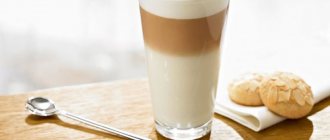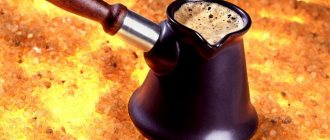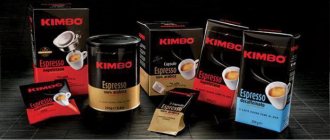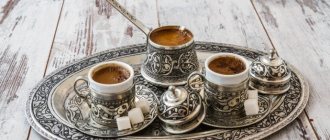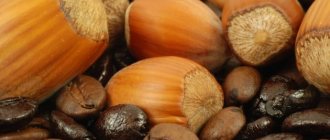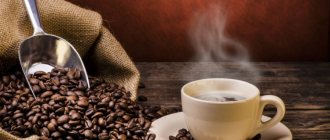Coffee has always been a success; its ability to invigorate and rich taste have always delighted lovers of tart drinks. Over time, more varieties are being developed by blending Arabica and Robusta and experimenting with grinding. And the addition of various ingredients gives simple espresso a unique taste. This is how Coretto appeared, who came to us from Italy.
Coretto - what is it?
The drink, behind the scenes, is considered a ticket to the society of gourmets who have a delicate taste and feel the whole flavor bouquet of bean coffee. This is an Italian coffee drink based on espresso and liqueur, which can be used as sambuca, Cointreau liqueur or fruit-flavored brandy. Not only is this drink distinguished by its rich taste, but also its easy preparation even at home.
Coretto has a beneficial effect on the body, for example, it speeds up metabolism and warms up during the cold season. Despite the fact that the birthplace of the drink is Italy, different countries create their own interpretation of Coretto.
For people suffering from high blood pressure, it is recommended to avoid such drinks.
This is how the Spanish version appeared - with the addition of rum or brandy. The proportions of alcohol and coffee depend on the taste of the client, and some countries also have their own preferences in the composition of coffee drinks.
In Catalonia they like more alcohol, in Castile or Leon the percentage of coffee is always higher. Sometimes, to obtain a richer taste and aroma, brandy and sugar are added, and the mixture is set on fire before cooking. This preparation method is most often used by coffee shops in Germany. This version of the drink is usually drunk in the morning, but Italians prefer to drink it after dinner.
Dopio
Everything is simple here, in the classical sense – it’s a double espresso. But now this drink is gradually disappearing, because... The very concept of espresso is changing. If earlier there was a clear distinction and a single espresso was prepared from one cone, two espressos from two cones, and dopio in most cases was 2 espressos in one cup, now everything is different. Now almost nowhere do they use a single horn due to its geometry, which does not allow achieving the necessary parameters for tasty espresso, and the structural features of most coffee machines, the diameter of the holders of which is still designed for a “double” bookmark. Most establishments are gradually moving towards preparing espresso for any drink in double-stack baskets. Therefore, the line between espresso and dopio is now blurred. In fact, modern coffee shops make all their drinks extra, slightly altering the menu where possible. Where it is not possible to make coffee on a dopio, they prepare espresso from one “spout” of a double holder, and the barista usually tries the second espresso, thereby checking that everything is in order with the settings.
Ristretto
Lungo, unlike ristretto, is translated as “elongated.” In ancient times, lungo was simply brewed a little longer than espresso, thereby obtaining a larger volume of the drink. Now such preparation is unacceptable. There are two options for preparing the right lungo:
- The barista changes his settings to get a properly brewed cup, but a larger volume and less concentrated flavor compared to espresso.
- Before preparing espresso, add 15-20 ml of hot water to the cup to soften the taste and add volume.
Both methods are correct and tasty, and the choice of method is up to the coffee shop.
How to cook it yourself
The invigorating effect of corretto depends on the quality of the coffee beans and compliance with the espresso preparation technology. The richness of taste and aroma is determined by the additive that traditionally served as grappa - Italian vodka made from grapes with a strength of 36-55°. Modern recipes for corretto allow it to be seasoned with sambuca, fruit brandy, Cointreau, other liqueurs and vodka.
The proportions of coffee and alcohol content vary depending on the preparation method. The share of the latter in the classic recipe reaches half the volume.
The preparation procedure is simple:
Ingredients for cooking
- Freshly ground fine coffee (7-9 grams);
- filtered water - no more than 100 ml;
- alcohol of choice - 20 ml (brandy, Cointreau, sambuca, cognac);
- sugar (1 - 3 spoons).
It is advisable to take 100% Arabica coffee beans, or a mix of Arabica and Robusta. You can use instant coffee; this method of preparation will be the most simplified.
The most commonly used alcohol additives are:
- aniseed vodka;
- Russian vodka;
- grappa (Italian alcoholic drink based on grapes 36% - 55% alcohol);
- sherry (Spanish sweet wine);
- brandy (grape);
- liqueurs (Cointreau, Sambuca, Baileys).
When adding Baileys liqueur, you should remember its sweetness; in this case, you can add less sugar.
How do Italians drink corretto?
The traditions of drinking this drink differ in different regions of Italy:
- residents of the northern part of the country drink it for breakfast;
- Southerners prefer to savor corretto after a hearty dinner;
- in some regions it is customary for the volume of the coffee component to significantly exceed the alcoholic component;
- in others, more attention is paid to the hop component.
When ordering Caffe corretto (cafe corretto), specify what kind of strong drink and in what quantity it will be flavored. Traditionally, coffee is flavored in equal proportions with a dose of grappa or brandy, but it can also be flavored with any alcohol of your choice.
An invigorating, aromatic “duet” will give a head start to the usual drink, refresh you after a hard day at work, and help you digest a large meal. Italians order and drink it at the bar. Doing it at a table will cost twice as much. At a coffee shop at an airport or train station, you may be asked to pay for your order immediately. Traditionally, corretto is drunk in one gulp, washed down with cold water. Enjoyment and energy boost are guaranteed!
Australian Lungo
Australian Lungo is an attempt to combine quick preparation in a coffee machine with the bright and multifaceted taste of filter coffee. Australian Lungo is a commercial version of Australian barista Matt Perger's signature drink at the World Barista Championship. Light roast beans, generally not intended for preparation in an espresso machine, need to be ground under a filter, but brewed like lungo. Finally, you need to filter the drink through a filter for Hario V60 pre-moistened in water to remove everything unnecessary, including any remaining cream. In practice, many coffee shops place a moistened AeroPress filter directly into the holder. The result is pure black coffee - rich, because it is brewed under pressure, and the temperature does not change throughout the brewing time, but without cream and oils. Outwardly, this coffee is similar to coffee brewed in an AeroPress, but its aroma is much richer and its body is denser. This drink should be drunk slowly, analyzing the aromas and tastes. Before drinking, you should let the drink sit for a while so that it cools slightly. Red eye, black eye, dead eye
A family of killer coffee drinks that vary in the number of espressos: 1, 2 or 3. The drink originated in America. It is not known who first came up with the idea of mixing two types of coffee prepared in different ways: in a drip coffee maker and in an espresso coffee machine. The result was a powerful energy drink, which was called red eye, since it causes a serious blow to the cardiovascular system, so those who abuse the drink often burst blood vessels, causing the whites of the eyes to turn red. At first, Red Eye coffee was the drink of night owl students, bohemians, and truck drivers. But in the 80s of the 20th century, this type of coffee was included in the menu of many cafes. A standard has been developed: filter coffee must be 120 ml, the amount of espresso depends on the variety of red eye.
Calorie content of the drink
The calories here are determined not by the coffee itself, but by its additives - liqueur, sugar and milk. Therefore, it is not recommended to consume Coretto in large quantities.
Let's look at the calories depending on the additives in the drink:
Alcohol:
- Coretto / grappa - 25.75 kcal.
- Coretto/brandy - 256.15 kcal.
- Coretto/sambuca - 26.25 kcal.
Sugar:
- Coretto / grappa - 45.10 kcal.
- Coretto/brandy – 45.50 kcal.
- Coretto/sambuca - 45.60 kcal.
Are there analogues of corretto in other countries?
The main components of the recipe complement each other so well that not only the inhabitants of the Apennine Peninsula thought of combining them. There are similar “energy drinks” outside Italy.
The most famous of them:
Spain. Carajillo, flavored with brandy or rum, is popular among the Spaniards. Variations are known with the addition of sherry and aniseed vodka. Sometimes, to enhance the aroma, the mixture of alcohol and sugar is set on fire before adding.
Ireland. An Irish classic - a coffee cocktail with whiskey and liquid cream. No less popular is the option with the addition of the famous Baileys Irish Cream liqueur.
Sweden and Norway.
Kaffekask is a traditional way of drinking coffee among Swedes. It involves adding vodka to the classic drink, which is why it is called Russian. Norwegians prepare a similar Karsk cocktail with an interesting presentation. A coin is placed in a cup and espresso is poured until it is out of sight. Then add vodka until the coin is visible again.
Italian coffee recipes
Borgia
Italian Borgia coffee is easy to prepare, but is a festive drink. Suitable for a romantic date and drinking coffee with friends.
For 2 servings you will need a double dose of ingredients. 2 teaspoons of coffee must be mixed with a pinch of salt. It is necessary to use the finest grind, essentially coffee dust. The dry components are placed in a Turk and placed on low heat.
After a minute, water is poured in and sugar is added to taste. When foam appears, the coffee is ready; it must be removed from the stove. The drink should be stirred and after a few minutes brought to a boil again. The next step is to add 1 teaspoon of cold water, this will allow the grounds to sink to the bottom.
Melt 50 g of extra dark chocolate in a water bath and place in cups of coffee. 1-2 teaspoons of powdered sugar are poured into 50 ml of cream. The mixture is whisked and piped on top of the coffee for garnish. If desired, the drink can be sprinkled with cinnamon.
Lovers of a strong drink add a pinch of salt to their coffee. This allows you to make the taste of the drink more rich.
Coffee Galliano
First you need to prepare 120 ml of espresso. Cooked in a Turk or prepared in a coffee machine is suitable. 120 ml of cream should be mixed with 15 ml of Galliano herbal and berry liqueur and whipped until thick. The resulting mixture should be placed on top of the coffee.
Mediterranean coffee Italian style
Add 2 teaspoons of finely ground coffee to the coffee and start brewing. Place 1 tablespoon of chocolate syrup, 2 teaspoons of sugar, half a teaspoon of anise seeds, a cinnamon stick and 1 clove in a separate bowl.
Cost of one serving
The cost of a cup of the drink depends on its filling and the price of the liquor added to the drink and the quality of the coffee. Coffee shops set an average price of 200 rubles and above.
You can choose your own alcohol from the menu so as not to pay for expensive liquor.
Undoubtedly, Coretto coffee is a real piece of Italy in every corner of the world. The aroma and rich taste will delight the coffee lover, enveloping him in a warming wave of a coffee drink with a hint of alcohol. Even in a coffee shop or restaurant, you can try to create your own version of Coretto by choosing your own alcohol.
Americano
A drink that coffee snobs hate, but guests love. Americano is a classic black coffee with a volume of about 120-130 ml. Its beauty lies in the balance of taste and volume of the drink. It is not too big so that you can drink it quickly enough, but not too small so that you don’t have time to enjoy the moment. Americano goes well with citrus fruits, so many guests ask for lemon, orange or lime. We won’t talk about the history of the drink; everyone has already heard many times about Americans in Italy who didn’t have enough espresso.
